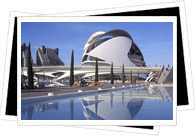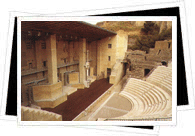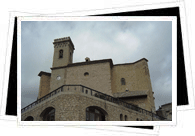
By polishing up the old and integrating the new, Valencia - home to paella, El Cid, the "genuine" Holy Grail and the pyrotechnics of Las Fallas- has been undergoing a major cultural Renaissance over the past couple of decades. A total revamping of Valencia's monument-packed historical quarter along with tons of cutting-edge projects, a cosmopolitan vibe and ambitious initiatives has revolutionized the city and turned it into one of Spain's most dynamic destinations. However, despite all the new "stuff," Valencia still proudly maintains and celebrates its its time-honored traditions, historical significance and seaport charm.
Valencia's highlights include the meandering streets of the El Carmen neighborhood, the Visigothic crypt of the prison of Saint Vicente the Martyr, the fascinating Gothic Silk Exchange, the Moderniste Mercado Central - one of Europe's largest covered market buildings- and the cathedral, which claims to have the Holy Grail of religious fame. A visit to Valencia would not be complete, however, without spending time in the City of Arts and Sciences. Amongst the sleek, futuristic buildings of the complex, you'll find lush gardens, a planetarium, an IMAX theater, an interactive science museum, an opera and performing arts center and Europe's largest aquarium.

Alicante, a tranquil but lively Mediterranean city, is the Valencia region's second largest town and a favorite amongst Spanish and international travelers alike. While many of its resort-laden Mediterranean neighbors have succumbed to the coastal tourism, Alicante is first and foremost a town very much tied with its culture, history, atmosphere and traditions.
The city, wedged between the sprawling hilltop Castle of Santa Bárbara and the lapping waters of the Mediterranean Sea, has a bit of everything- beaches, award-winning museums, great shopping, ancient monuments, modern additions, etc. Set around the Cathedral of San Nicolás is the old quarter, commonly referred to as El Barrio. Brimming with a "typical Spanish" atmosphere, this old section of Alicante features winding streets, a lively atmosphere, cute street cafés and the town's most vibrant nightlife. Head towards the shore for Alicante's famous Explanada de España, a colorfully-tiled promenade running parallel to the sea and lined with palm trees and terrace cafés.

A popular excursion from the city of Valencia is Sagunto, a town dating back as far as the 5th century BC- the epoch of Valencia's Iberian tribes. The town's highlights span centuries and civilizations- a 1st century Roman theater and Diana Temple remains, a Jewish quarter, winding medieval streets, picturesque squares, whitewashed houses, churches and hermitages, a nearly one kilometer long fortified wall and an incredible castle. While much of the fortress is in ruins today, its seven parts attest to different periods and different civilizations in Sagunto's long history.
The Valencian town of Guadalest is a favorite amongst tourists; yet the influx of tourism has not chipped away one bit at his typical atmosphere. Essentially set atop a 500-meter high rock, the pedestrian cobblestone streets of the extremely well kept old quarter - declared a Historic-Artistic Site - are flanked by traditional whitewashed houses and architectural monuments.
Some of Guadalest's most revered highlights include the 18th century Church of Nuestra Señora de Asunción, the 12th-century prison hidden beneat the City Hall and the ruins of the town's 11th century Castle of San José. Venture to the castle via a natural tunnel in the rock for incredible panoramic views of the surrounding landscape. Guadalest also garners fame for its handful of rather quirky museums, ranging from the Municipal Museum-House of Orduña to the Museums of Micro-miniatures, Micro-giants, Ethnology, Nativity Scenes and Dollhouses, and even Torture Devices.
Often snubbed and skipped over by both Spanish and foreign visitors, the city of Murcia has the lengthy history of ups and downs, vibrant university nightlife, fantastic monuments and welcoming atmosphere of any top-notch Spanish metropolis. Just get through the industrial outskirts and into the laid-back and mostly pedestrianized heart of the city- full of beautiful architecture, noble mansions, atmospheric bars and picturesque streets begging for a leisurely stroll.
Add the following sights to your Murcia itinerary. The 19th century casino; opened as a gentlemen's club in 1847, the Baroque façade welcomes you into an Islamic-style vestibule and interior courtyard. The Calle de la Trapería, an atmospheric street and major vein of medieval and Renaissance Murica. The Cathedral de Santa María, a 15th century edifice raised upon the site of a mosque, began in the Gothic style but was later adorned in the Baroque style, a result of the city's 18th century silk industry and agricultural prosperity. Take in the sumptuous Baroque façades, complete with over-the-top decoration and tumbling cherubs, before climbing the tower for unbeatable vistas.
Occupied since the days of Spain's Iberian tribes and Roman presence, the delightful town of Caravaca de la Cruz began to take on its present-day appearance under the Moors. The town climbs up a hill, upon whose peak sits the impressive castle and its slew of defensive towers. Declared of Historic-Artistic Heritage, the castle dates back to the Moors, with 15th century additions attributed to the Knights Templar.
Having passed through the hands of both the Knights Templar and the Order of Santiago in the years following the Christian Reconquest, the town's rich architectural splendor is due in great part to its religious heritage- in fact, it is actually considered to be the 5th holiest city in the world! Along with the castle, be sure to pay a visit to the Baroque Sanctuary of the Santísima y Vera Cruz (17th century) found within the castle, the Baroque Church of Salvador (17th century), the Carmelite Convent, and the 16th century Church of the Purísima Concepción- a Renaissance edifice boasting Baroque features and incredible Mudéjar coffered ceilings.

Whether bathed in bright summer sunshine or capped in snow, the pretty village of Moratalla is nestled amongst pines and oaks in Murcia's most mountainous, wooded area. Its secluded hilltop location yields steep and winding medieval streets that climb until they reach the foot of the castle- a 9th century fortress constructed by the Moors with later Gothic additions from the post-Reconquest days. Moratalla, an attractive architectural ensemble in itself, is a picturesque town mixing monumental buildings of warm stone with quaint whitewashed homes. An unmistakeable vibe of history and antiquity emanates from each cobbled stone and pretty plaza.
Moratalla's highlights include the 16th century Parish Church of Santa María de la Asunción; the 17th century Hermitage of Santa Ana; the 15th century Convent of San Francisco; the simple 16th century Hermitage of La Rogativa; and stone bridges originally built by the Romans and still in use today!
Mazarrón is actually a two-stop place, as the port of Mazarrón sits on the shoreline three kilometers from the inland village of Mazarrón. The port of Mazarrón is set along the 35 kilometers of unspoiled coastline comprising a wide bay opening up to the Mediterranea Sea. Along with seaside walks, beaches and coves and the defensive towers of Cumbre and Caballos, stroll around the fishing port and lively fish market for a taste of Mazarrón's historic seafaring tradition.
The village of Mazarrón is a small, tranquil hamlet with a surprisingly delightful and eclectic ensemble of architectural treasures, welcoming plazas and antiquated streets. A few of the highlights attesting to the village's earlier days include the ruins of the Vélez Castle, the Convent of Las Purísimas and the Church of San Andrés with its incricate Mudéjar coffered ceiling. An economic boost throughout Murcia at the beginning of the 20th century also led to a few Moderniste buildings, such as the Mazarrón City Hall and the Old Cultural Association.